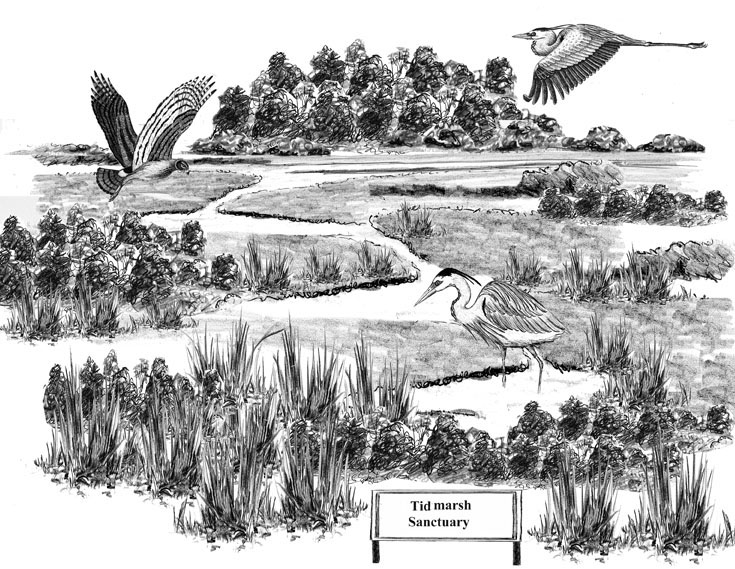
Tidmarsh is back!
I’m sure that statement doesn’t make much sense to most folks reading this, but believe me, this is good news…very good news.
Last week, I was catching up on some reading when I noticed an article by Lisa Schibley in the June issue of Bird Observer. Lisa wrote about Mass Audubon’s Tidmarsh Wildlife Sanctuary in Plymouth. This was news to me. Admittedly, I haven’t spent much time birding in Plymouth. I once went to Plymouth Municipal Airport to look for Upland Sandpipers and years ago I visited Plimoth Plantation. I remember it being an interesting place and the people there were very nice (except they didn’t know how to spell Plymouth). So, where did this Tidmarsh sanctuary come from? It’s a great story, and with habitat disappearing faster than ever, it’s also a rare bright spot.
For centuries, the area in question was a flourishing coastal wetlands. But in the 1890s, someone decided the land would be better used for growing cranberries. The habitat was altered, vegetation was removed and several brooks were dammed up, including, conveniently, Beaver Dam Brook. As cranberry bogs go, Tidmarsh Farms was a success and a major contributor to Ocean Spray. But things began to change when varieties of cranberries from Wisconsin started taking over the market. (What makes the Wisconsin berries so popular? I’m not sure, but my guess is they’re filled with cheese.) The owners of Tidmarsh Farms took this as a sign that it was time to hang up the berry scoop and put the property up for sale. Developers quickly got in line, with one group suggesting a 400-house subdivision. Yikes! But instead of selling to the highest bidder, the conscientious property owners chose to return the land back to nature. Can you believe it? Mass
Audubon and the town of Plymouth chipped in to buy most of the property, with state, federal and other agencies providing money to remove the dams. They also brought in thousands of native plants and fish in order to restore the wetlands. And in 2018, Tidmarsh Wildlife Sanctuary opened. Was all of the work worth it? Lisa said it was, but I had to see for myself. I went the very next day.
I arrived at Tidmarsh just as the sun was coming up and noticed that the parking lot was empty. Sweet! I would have all 481 acres to myself. I stepped out of the car and was greeted by a grumpy Great Blue Heron flying overhead. I took this as a good sign. I quickly came to a small pond filled with frogs and lily pads. A posted sign advised me to look for the resident river otter. I looked, but only saw frogs and lily pads. (The sign lied.) The trail soon opened up to a dry field filled with large rocks. Perhaps this area once served as a sandpit that provided sand for the bogs, but now it was rather barren and looked more like the backdrop of a TV Western. It also wasn’t very birdie. So far, my walk had been fairly lackluster, but then I turned the corner and came to the restored wetlands. Now yer talkin’.
I don’t know what Tidmarsh looks like other times of the year, but on this fall day the colors were dramatic. Red maples, cattails, purple asters and goldenrod all helped to frame the sparkling water. The catbirds hadn’t left the area yet and were yapping away as usual. A flock of Red-winged Blackbirds settled into the reeds and swimming in front of them was a lone Pied-billed Grebe. I moved over slightly to get a better view, but it was a mistake. Grebes have the haunting ability to disappear below the surface without even making a ripple. The bird was simply gone. But before I could totally blame myself, I saw another reason the grebe had vanished. A Northern Harrier was hunting low, gliding just above the water. It was pretty cool. Forget what I said about my walk being “lackluster.”
A sign pointed to the Boulder Loop Trail. This trail is really short and well worth taking. It wound through more fall flowers, with lots butterflies and offered closer views of the water. There was also a real boulder, so this time the sign hadn’t lied. A lively phoebe soon caught my eye and nearby a Nashville Warbler was busily eating a wormy thing. A Northern Parula was also looking for lunch, as were several other actively feeding warblers. I would love to tell you which warbler species they were, but the birds moved too quickly. Yellow and blurry is the best description I can give you. I hope that helps.
As the warblers moved on, a smaller bird flew into a brush pile in front of me. I approached the pile, assuming the bird would fly and then I could check it out. It didn’t move. Hmm. I peered into the brush and there, looking back at me, was a tiny Winter Wren. This mouse-like bird is often overlooked since it would rather creep through the tangles than fly away. I took a few fuzzy photos and left it alone. On my way back to the parking area I saw another heron, hundreds of swallows, a pair of Wood Ducks and more fall flowers. Cranberries are fine, but this was better…way better.
The effort to restore Tidmarsh is the largest such project ever undertaken in New England and it couldn’t have come at a better time. It’s nice to know that at least our local citizens and civic leaders will still stand up for what matters. Tidmarsh Wildlife Sanctuary is just off exit 3, on Rt. 3 in Plymouth and I totally recommend a visit. Just remember, the name is “Tidmarsh,” not “Tide Marsh,” as I pronounced it the first five times. (That’s what I get for teasing the Plimoth Plantation people for not being able to spell Plymouth.)